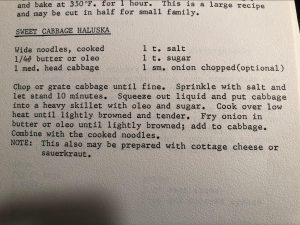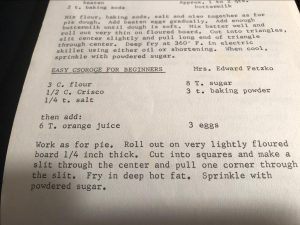Interview with Pat Germek, a second generation Hungarian-American
By Sarah Rosenthal • December 13, 2018
I am lucky to have a wealth of knowledge on Hungarian cuisine on my phone’s speed dial―my grandma, Pat Germek, grew up living across the street from her Hungarian immigrant grandparents, attending a Hungarian Catholic Church, and participating in many Hungarian and Hungarian-American customs and traditions. Her insights into Hungarian cuisine and its place in her life are invaluable, and I feel so fortunate to have learned so much about my family’s history in the process of interviewing her. Grandma was also gracious enough to share a few photos of her childhood church’s community cookbook, which you can find following the transcript of the interview.
Tell me a little about your childhood and family.
I had four sisters, and we lived in a small house in Pennsylvania with only two bedrooms. All four of us sisters shared a bedroom. Our Hungarian grandparents lived across the street, and my grandma always made all kind of stuff like noodles, homemade noodles.
What’s your earliest food memory?
Oh, definitely chicken soup.
Did your mom make the soup?
Yup, from scratch! She boiled the chicken and picked it apart. She made it probably every week with my grandma’s homemade noodles.
I bet that was good!
It was, I loved those noodles. But yeah, I would say chicken soup. We also used to have a big dinner every Sunday. They would start really early, we’d eat our big dinner at noon or one o’clock. It would always be chicken, pork chops, or roast beef. It would be a great big huge dinner, but at lunchtime.
So after church?
Yeah, after church. We went to church early, and we’d come home from church at around nine o’clock and start cooking dinner.
Is there a particular Hungarian dish that holds a lot of meaning for you? You mentioned noodles, but is there anything else?
Um, the chicken paprikash we had all the time. We probably had that every couple of weeks. Goulash, Hungarian goulash. Oh yeah, a lot of different cookies, Hungarian cookies, like apricot cakes and nut rolls. At Christmas, they would spend days baking those things! Oh yeah, and our church made csoroge, which is like a donut, a fried donut. I love those things. I have a special cutter to make them.
And they made them at church?
Yeah, well we went to a Hungarian church.
I didn’t know that!
Yeah, they had two masses, the early mass was all sung in Hungarian, and the second mass was in English.
That’s awesome, I didn’t know that!
Yeah, and Pappy, my dad, spoke Hungarian and he was the cantor at the church, so he had to go through both masses and he sang the mass in Hungarian with the priest.
Wow, so did your grandparents go to the Hungarian mass?
Yes, because they hardly spoke any English. Well, they spoke some English, but around my mom they always spoke Hungarian because they didn’t want her to know what they were saying.
That’s really funny, I didn’t know that. So, do you think your Hungarian heritage has anything to do with the flavors you enjoy now?
Yeah! Well, I….No. I don’t think so. (laughter) I really like Italian food, so I don’t think so! Like anything Italian with sauce. I would say that we never ate that kind of food.
Really?
Occasionally we had spaghetti, but it wasn’t homemade, it was like the Chef Boyardee kit that you bought at the store. But we never had lasagna or anything Italian, so I really like Italian food now. I wouldn’t say that we eat a lot of the Hungarian food now. I mean, some of the Hungarian things, like I didn’t eat it, but pickled pigs feet, it was kind of disgusting stuff, truthfully. That was something they made. I didn’t make it, my grandma made it and my dad ate it…
And she would make them? Like, pickle the feet?
Yeah! Pigs’ feet. Like in a jelly, it was disgusting. My dad ate it.
Blegh.
Oh, then we always did this in the summer, it was a big thing! It was called szalonna, and I don’t know if I’m saying it right, but they would get a big square slab of uncooked bacon, and they’d make a fire, and then all the families would come and they’d roast the bacon in the fire until it dripped, and they’d drip it on rye bread, and people would just eat the bread!
Oh, I found it! I just googled it!
You did?
Yeah! It says “szalonna is Hungarian fat-back smoked pork fat with the rye over a campfire.”
Yeah! That’s it. We did that like, a couple times a year in the summer. It would be like a big picnic and all the men would sit around the fire with a big hunk of that stuff on a stick, and they’d just have loaves of bread and people would just eat the bread.
Huh!
It was really good, I remember it! That’s why everyone in our family is fat. (laughter)
It’s like barbeque though! Like Hungarian barbeque.
Yeah…but it’s just like fat drippings on bread! Literally I mean, that’s what it was! When it got drippy, they’d put it on the bread, and the people would just eat the fatty bread. It was almost like butter! Then they’d roast some more, and it would drip again, and they’d put it on more pieces of bread.
I’m learning so much!
Ha, that’s what we are going to do for your birthday! We are gonna get a fire pit out back, and a big hunk of bacon…
I mean it sounds really good! I just never would have known that. I know about chicken paprikash and goulash, but that’s something I never would have known. Okay, tell me about the process of making the Hungarian noodles.
Oh gosh, it would be an all-day affair. Because you had to make the dough, and then you had to roll it all out, then you had to let the dough kind of dry. My grandma made two different kinds of noodles, she made the long skinny noodles like regular noodles, and then she made these really little tiny noodles, they were probably only half an inch. She’d cut them into tiny little squares, almost like confetti. Then when the noodles were dry, she’d just send them over to our house in a brown paper bag. You could keep them for a while, just like you’d buy noodles at the store, and then when you wanted to use them you’d just put them in boiling water or in your soup. But they’d be dry, just like noodles you buy at the store.
How often would she make those?
Oh gosh, she probably made them every two weeks? Because a lot of the recipes needed those noodles, like the soup. Soup was really big back then because it was cheap, and you could feed a lot of people with it. The chicken paprikash used the noodles. We ate a lot of noodles, probably more than we ate potatoes. We never, ever had rice. Never. Noodles was the thing. I don’t know why, you just make the noodles with flour and eggs and water and salt, so I guess they were cheap to make.
You mentioned church earlier, that was a really big part of your growing up with Hungarian heritage. Do you have any food memories related to holidays?
Haluska was something everyone ate during Lent. It’s basically cabbage and noodles, I love it!
I read about Haluska! Did you only eat it around Lent?
You could eat it anytime, but especially during Lent because it doesn’t have meat.
What about Easter?
Hungarian Easter cheese! It was a must to make at Easter. Aunt Debbie and just about everyone else still makes it, but I hated it. You took it in a basket to church on Holy Saturday mass. After church, everyone went to the church hall and the priest came and blessed the baskets, which held the Easter cheese, colored eggs, a candle, Easter ham, and bread called Paska. Then on Easter, you’d eat all the blessed food. The funniest thing was that everyone tried to outdo each other’s baskets. They would all have fancy embroidered linens, it was a big competition.
That’s hilarious. Aunt Deb really holds on to a lot of Hungarian traditions, is there anything else she makes that you don’t anymore?
Oh, stuffed cabbage! We always ate that for every holiday. It’s always made with a special mix of pork and beef from the butcher shop. They would make a huge roaster of them, maybe a hundred!
You and Pappy still love to eat stuffed cabbage!
We do, but it’s such a pain to make. Aunt Debbie is the stuffed cabbage queen, she still makes it all the time and even made a video of how she does it.
Talking with my grandma about our family’s Hungarian heritage and the traditions she grew up with really opened my eyes to the ways Hungarian culture and cuisine have influenced our family’s current generations. Although we may not eat things like pickled pigs’ feet or bacon drippings on rye bread anymore, the culinary traditions surrounding these types of dishes have definitely carried through our family through our love of cooking together and traditions like family barbeques in the summer. The simplicity of Hungarian cuisine makes it accessible, delicious, and familiar to young and old members of the family alike.


